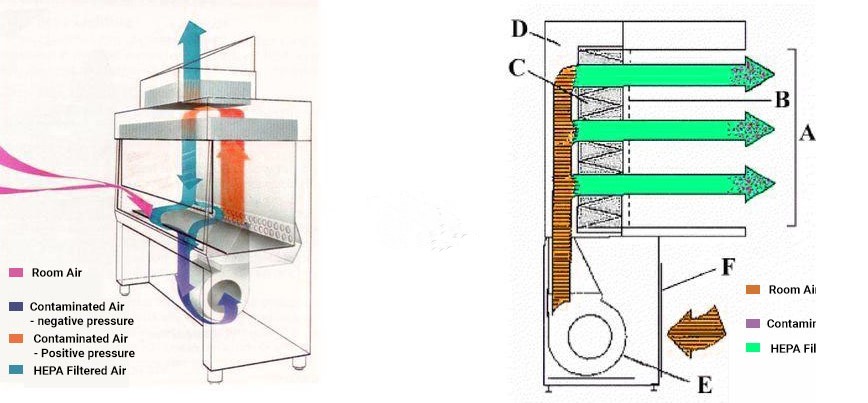Key Considerations for Selecting BSCs and Laminar Flow Hoods
When selecting a Biological Safety Cabinet (BSC) or
Laminar Flow Hoods for different applications, there are several factors to
consider. Here are some key considerations to help guide your selection process.
Compare the airflow diagrams for the Biological Safety Cabinet (on the left) with the Horizontal Laminar Flow Hood (on the right).

-
Application Requirements
Determine the specific requirements of your application. Consider factors such as the type and level of biological or chemical agents being handled, the necessary level of containment, the size and quantity of samples or materials, and any specific equipment or accessories needed for your work.
-
Safety and Containment Level
Evaluate the level of safety and containment required for your application. BSCs are classified into different types (e.g., Class I, Class II, Class III) based on their design and level of protection. Assess the risk level associated with your work and select a BSC that provides the appropriate level of protection.
-
Airflow and Filtration
Consider the airflow and filtration requirements. Determine whether a laminar airflow or containment type (e.g., HEPA-filtered downflow) is needed for your application. Evaluate the efficiency and effectiveness of the airflow and filtration system in removing particles, contaminants, and potentially hazardous materials.
-
Size and Capacity
Assess the size and capacity requirements for your work. Consider the dimensions of the BSC or workbench and ensure it can accommodate the necessary equipment, samples, and materials. Determine if you need a larger unit or if multiple units can be used to meet your requirements.
-
Ergonomics and User Comfort
Consider the ergonomics and user comfort features. Evaluate factors such as sash height adjustability, footrests, armrests, and the overall design of the BSC or workbench to ensure comfortable and efficient operation for extended periods.
-
Certification and Compliance
Ensure that the BSC or workbench meets relevant industry standards and guidelines. Look for certifications such as NSF/ANSI 49 or EN 12469 to ensure compliance with international safety and performance standards.
-
Maintenance and Service
Consider the ease of maintenance, cleaning, and service requirements. Look for features such as easy-to-access filters, removable work surfaces, and user-friendly control panels that facilitate regular maintenance and reduce downtime.
-
Budget
Determine your budget and consider the cost-effectiveness of different options. Evaluate the initial purchase cost, as well as long-term operating costs such as energy consumption, filter replacement, and maintenance requirements.
-
Regulatory Compliance
Ensure that the selected BSC or workbench complies with relevant regulatory requirements specific to your industry or region, such as Good Laboratory Practices (GLP) or Good Manufacturing Practices (GMP) guidelines.